

Labs & Activities - Cornell Institute for Biology Teachers. Skip to main content Search Filters: Main Navigation Search Cornell Cornell Institute for Biology Teachers menu Home Browse Labs & Activities: Labs & Activities.
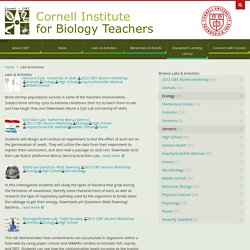
Ecology Lesson Plans: Environment, Energy Flow, Cycles. The American Chestnut Foundation - The Charlie Chestnut Environmental Education Program. Charlie Chestnut is The American Chestnut Foundation's in-class and online interdisciplinary curriculum designed to inspire students to learn more about the environment and about American chestnuts.

Aquaponics Lab at Burlington High School. Posted by bsciencecenter in Uncategorized.
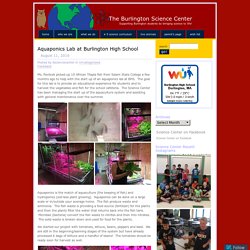
Trackback Ms. Pavlicek picked up 10 African Tilapia fish from Salem State College a few months ago to help with the start up of an aquaponics lab at BHS. The goal for this lab is to provide an educational experience for students and to harvest the vegetables and fish for the school cafeteria. The Science Center has been managing the start up of the aquaculture system and assisting with general maintenance over the summer. Aquaponics is the match of aquaculture (the keeping of fish) and hydroponics (soil-less plant growing). We started our project with tomatoes, lettuce, beans, peppers and basil. Check out BCAT’s news brief below for a close-up view of the aquaponics lab. Teaching Resources. Ecology: HS Science - K-12 Education. How does human activity impact ecosystems and what evidence-based solutions may help mitigate the human impact?
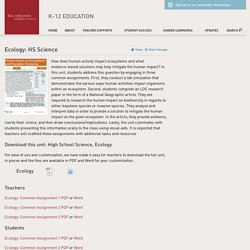
In this unit, students address this question by engaging in three common assignments. First, they conduct a lab simulation that demonstrates the various ways human activities impact organisms within an ecosystem. Second, students complete an LDC research paper in the form of a National Geographic article. They are required to research the human impact on biodiversity in regards to either keystone species or invasive species. Ecologybyinquiry. Project Coyote. Pennsylvania Project Learning Tree. ProjectWILD. Ecology Box. The Ecology Box covers ecosystems, food webs, habitats, and water/soil quality monitoring.
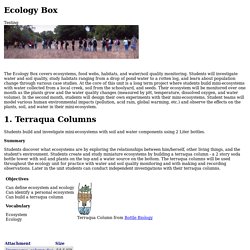
Agriscienceappendixa.pdf. SAPS - Making an eco-column. Browse Interactives. BottleBiology.pdf. Ecosystem. Take your students to Peru for free (live on youtube on March 16th at Noon Eastern)!

Your class will investigate the amazing biodiversity of a coastal ecosystem as they explore the Humboldt Current! On the trip students will also see sea birds, penguins and flamingos! Along with fisheries scientist Matias Caillaux, they will travel by boat to an island that has more than 30,000 sea lions at a time! They will discover how the Humboldt Current pushes vital nutrients toward the surface and forms the "basis of a unique and abundant ecosystem. " They will also learn the importance of protecting an ecosystem so its inhabitants and the region's fishing industry remain thriving. This trip is a great opportunity to cover science and geography standards through problem-based learning. Field Trip Information How Nature Works in Coastal Peru: The Amazing Biodiversity of a Coastal Ecosystem Subject focus: Science and Geography.
Home - www.TeachEngineering.org. Biodomes Engineering Design Project: Lessons 2-6. Summary In this multi-day activity, students explore environments, ecosystems, energy flow and organism interactions by creating a scale model biodome, following the steps of the engineering design process.

The Procedure section provides activity instructions for Biodomes unit, lessons 2-6, as students work through Parts 1-6 to develop their model biodome. Subjects include energy flow and food chains, basic needs of plants and animals, and the importance of decomposers. WA18_How_Healthy-T.pdf. Agrisciencelesson11.pdf. Life Science. Course Overview From aardvarks to zebras, the living world provides diverse opportunities for learning in the natural sciences.
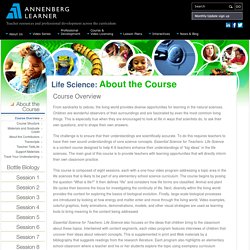
Children are wonderful observers of their surroundings and are fascinated by even the most common living things. This is especially true when they are encouraged to look at life in ways that scientists do, to ask their own questions, and to shape their own answers. The challenge is to ensure that their understandings are scientifically accurate. To do this requires teachers to have their own sound understandings of core science concepts. This course is composed of eight sessions, each with a one-hour video program addressing a topic area in the life sciences that is likely to be part of any elementary school science curriculum.
Essential Science for Teachers: Life Science also focuses on the ideas that children bring to the classroom about these topics. Session Descriptions. Biosphere-bottle.pdf. BottleBiology.doc. Bottle Biospheres. Bottledecosystem.pdf. A Student Produced Field Guide to Neighborhood Trees. Summary During this project, students will be working cooperatively to create a field guide of trees in the neighborhood near the school.
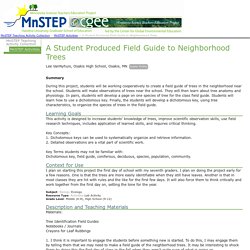
Students will make observations of trees near the school. They will then learn about tree anatomy and physiology. In pairs, students will develop a page on one species of tree for the class field guide. Students will learn how to use a dichotomous key. Learning Goals This activity is designed to increase students' knowledge of trees, improve scientific observation skills, use field research techniques, includes application of learned skills, and requires critical thinking. Key Concepts: 1. Fgfp.pdf. Web-based Student Activities. These student activities represent the diversity of science conducted at the Museum and encourage the development of science inquiry and critical thinking skills.
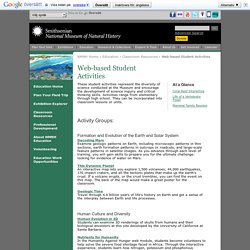
Activities range from elementary through high school. They can be incorporated into classroom lessons or units. CSIP Student Inquiry Projects - Science Lesson Plans and Curriculum Resources. Grabbing a Bite to Eat. In this activity, students will perform an experiment that replicates the dilemma faced by birds in acquiring food from a confined area.
Students will be given a variety of objects to use as “tools” and explore various ways of extracting the food item from an enclosed shoebox without directly using their hands. Students will compare and contrast which tools worked best and use problem-solving skills to design and develop unique methods for extracting the food item from the shoebox. RAFT Bay Area - Resource Area For Teaching. RAFT Needs Your Support Join RAFT and Silicon Valley Community Foundation for Silicon Valley Gives, a one-day event to bring community and nonprofits together in a big way. Donations will be matched 1:1, $10 becomes $20! Read More It’s a day of unprecedented online giving on May 6th. Ecology Lesson Plans: Environmental Science, Ecosystems, Cycles. EarthLabs.
How Can We Clean Up an Oil Spill?